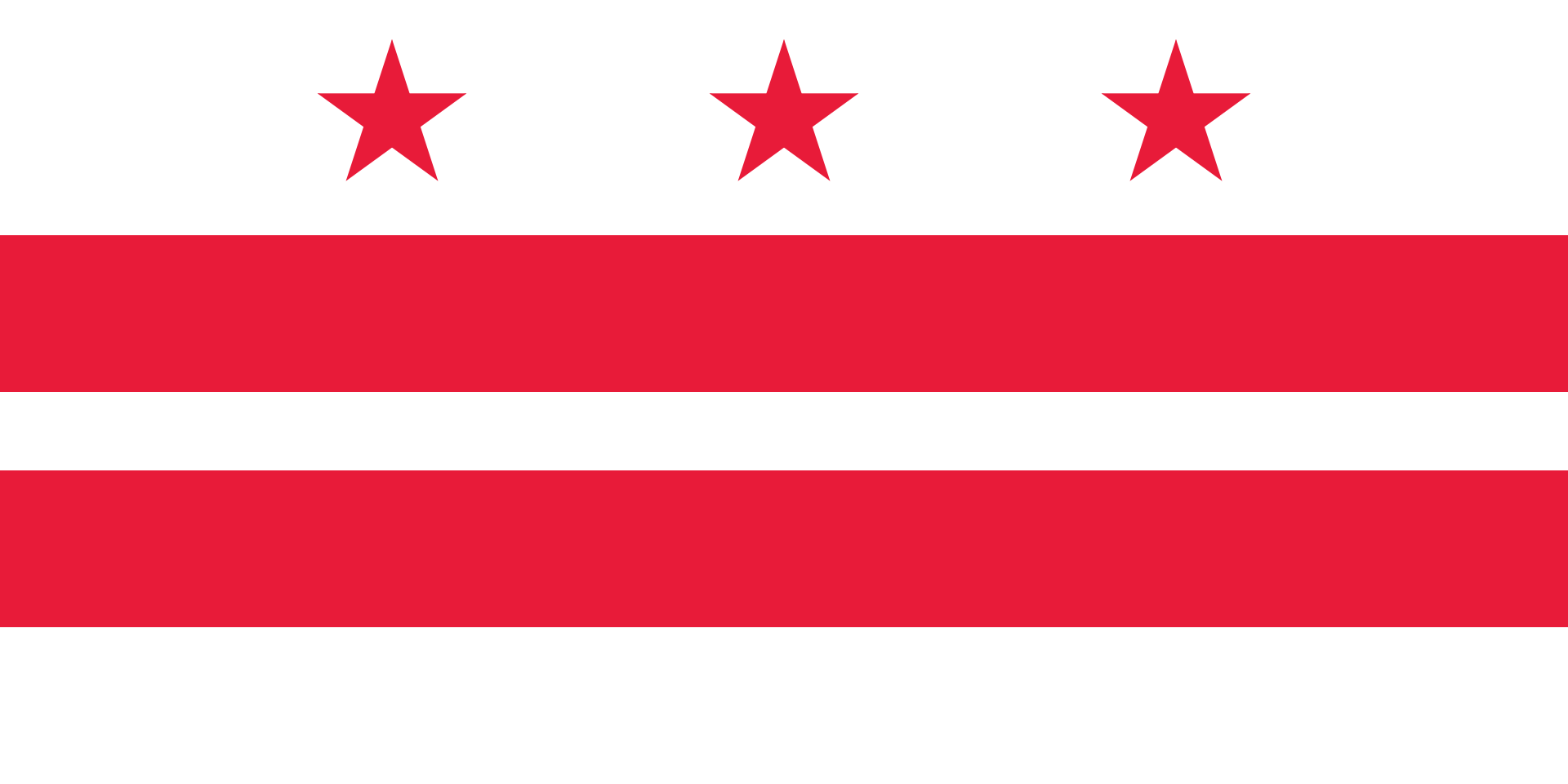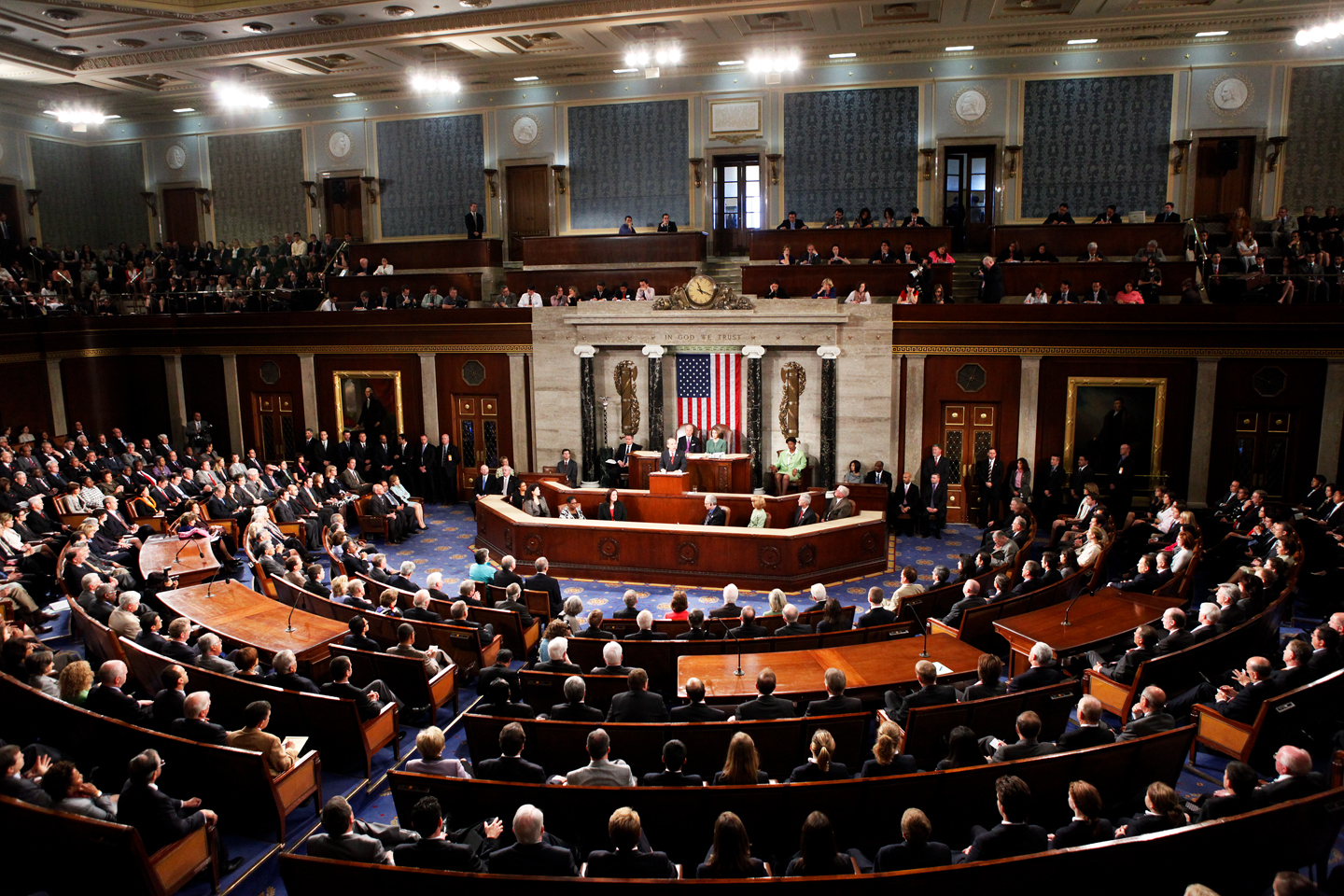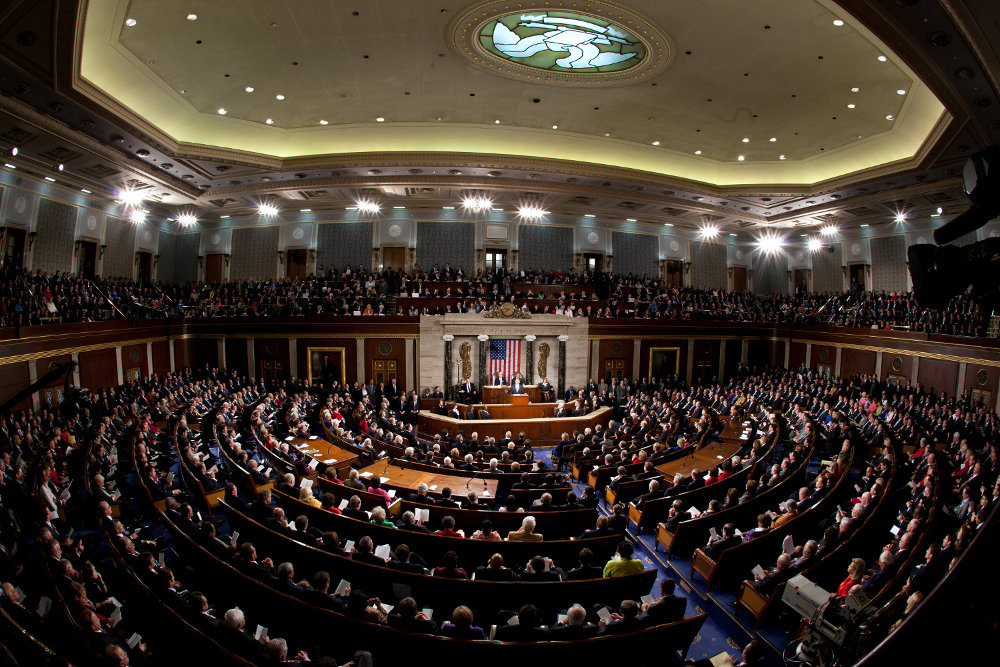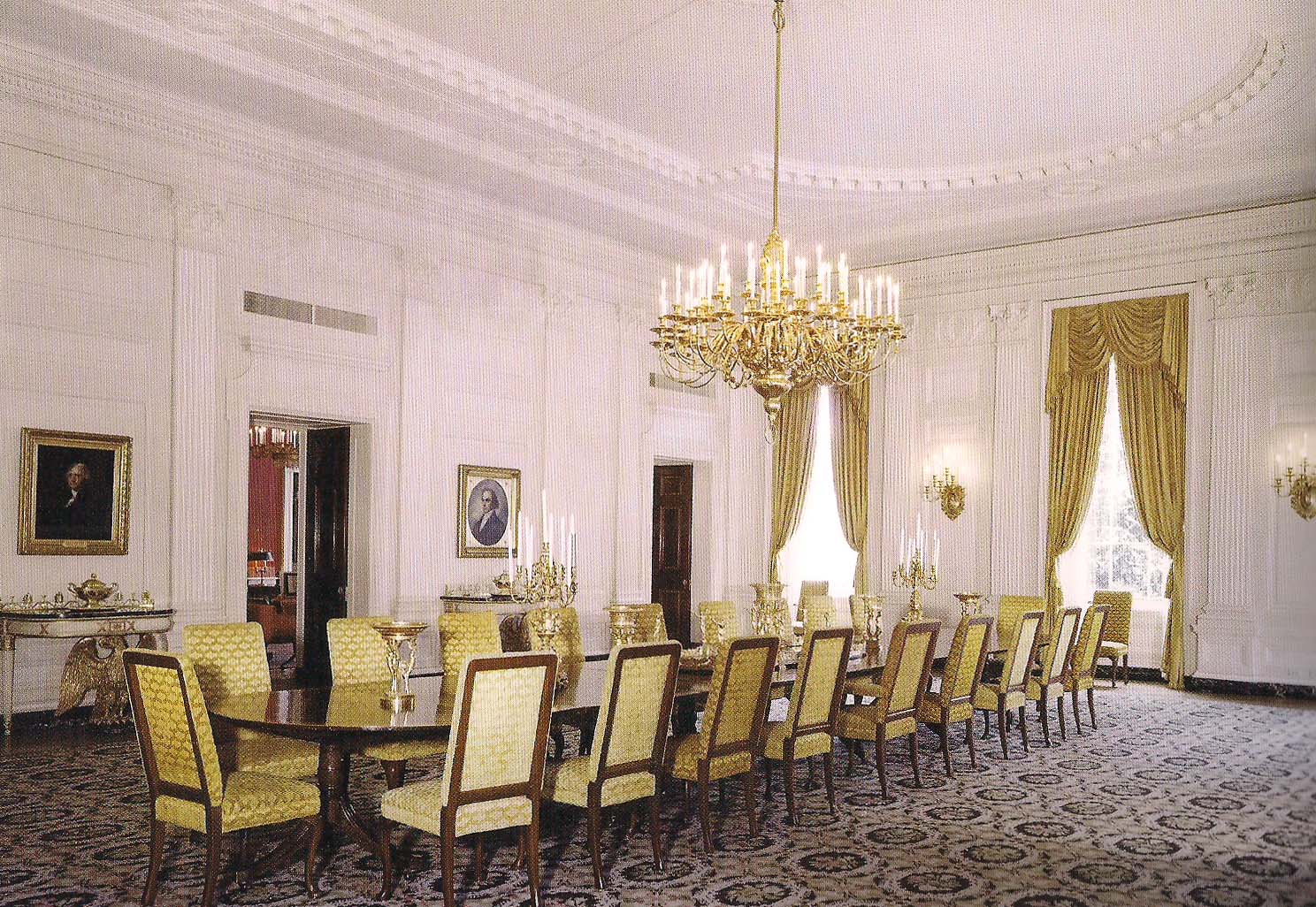
Deutsch-Chinesische Enzyklopädie, 德汉百科
 Washington, D.C.
Washington, D.C.


 *United States Political System
*United States Political System

 Financial
Financial
 *United States economic data
*United States economic data
 United States
United States

 Washington, D.C.
Washington, D.C.


美利坚合众国众议院(英语:United States House of Representatives)是美国的立法机构──美国国会的两院之一,另一院为参议院(上议院)。众议院议场建筑物分布在首都华盛顿特区的国会山庄南部。由于美国各州也设有州众议院,为避免混淆,有时会将美国众议院称为联邦众议院。
众议院是美国的下议院,美国各州在众议院中拥有的席位比例以人口为基准,但至少会有一名议员。众议员总数经法律明定为435名。此外,目前有6名无表决权的议员,使众议院的总人数最多能达到441人[1]。众议员任期两年,无连任限制。众议院议长由众议员选举产生,传统上为多数党领导人。然而多数党领袖另由该多数党于院内之第二重要议员担任。据美国总统继位条例,众议院议长继任总统之顺序仅次于美国副总统,为政坛上第三重要的领袖人物。
众议院一般被认为较参议院更具党派色彩。美国宪法制定者中有很多人企图让参议院(1914年前是由州议会选举)成为众议院(公民直选)的制衡机关。于是“建议与同意权”(如批准条约权力)授权仅由参议院单独行使。众议院也有其独有的权力:倡议岁入法案之权、弹劾政府官员、以及在美国选举团僵持不下时选举总统。然而,所有这些权力都可由参议院制衡(counter-check)。参议院一般较众议院更具威望,参议员任期较长、人数较少、且(多数情况下)较众议员代表更多的选民。
两院制国会的起源是因为美国开国元勋们,希望拥有一个贴近跟随民意公论的“人民议院”,和代表各州利益而不太受大众情绪干扰的参议院相互制衡。宪法规定法案须经两院批准方能通过。
众议院会议厅位于首都华盛顿特区的美国国会山庄南翼。参议院在同一建筑物的北翼开会。
Das Repräsentantenhaus der Vereinigten Staaten (auch Abgeordnetenhaus; englisch United States House of Representatives, oft nur the House) ist neben dem Senat eine der beiden Kammern des Kongresses der Vereinigten Staaten von Amerika. Es steht in der Tradition der Zweikammer-Parlamente (Bikameralismus), die im britischen Parlament ihren Ursprung hat. Jeder Bundesstaat ist nach dem Anteil an der Gesamtbevölkerung im Repräsentantenhaus vertreten. Die wahlberechtigten Bürger der USA wählen die Abgeordneten im November der geraden Jahre für je zwei Jahre in ihrem jeweiligen Kongresswahlbezirk.
Im politischen System der USA ist das Repräsentantenhaus maßgeblich an der Gesetzgebung beteiligt und hat einige Kontrollfunktionen gegenüber dem Präsidenten. Es besitzt das alleinige Initiativrecht bei Steuer- und Haushaltsgesetzen, darüber hinaus kann nur dieses Haus ein Amtsenthebungsverfahren einleiten.
アメリカ合衆国下院(アメリカがっしゅうこくかいん、英: United States House of Representatives、略称: the House[注釈 1])は、アメリカ合衆国議会の二院[1]のうち下院にあたる議院である[2]。
アメリカ合衆国代議院(アメリカがっしゅうこくだいぎいん)とも翻訳される[3][4][5]。議席数は435で、各州に対して人口比率に応じて配分される。「上院 (upper house)」「下院 (lower house)」という言葉は、アメリカの首都がフィラデルフィアであった頃、議会が使用していた2階建ての公会堂(現在の独立記念館、当時の大きめな家屋と変わらないほどの小振りな建物)で、議員数の多い代議院 (House of Representatives) がその1階部分 (lower house) を、少ない元老院 (Senate) が2階部分 (upper house) を使用したことからこう呼ばれ始めたといわれる。
The United States House of Representatives is the lower chamber of the United States Congress, with the Senate being the upper chamber. Together, they comprise the national bicameral legislature of the United States.
The House's composition was established by Article One of the United States Constitution. The House is composed of representatives who, pursuant to the Uniform Congressional District Act, sit in single member congressional districts allocated to each state on the basis of population as measured by the United States Census, with each district having one representative, provided that each state is entitled to at least one. Since its inception in 1789, all representatives have been directly elected, although universal suffrage did not come to effect until after the passage of the 19th Amendment and the Civil Rights Movement. Since 1913, the number of voting representatives has been at 435 pursuant to the Apportionment Act of 1911.[1] The Reapportionment Act of 1929 capped the size of the House at 435. However, the number was temporarily increased in 1959 until 1963 to 437 when Alaska and Hawaii were admitted to the Union.[2]
In addition, five non-voting delegates represent the District of Columbia and the U.S. territories of Guam, the U.S. Virgin Islands, the Commonwealth of the Northern Mariana Islands, and American Samoa. A non-voting Resident Commissioner, serving a four-year term, represents the Commonwealth of Puerto Rico. As of the 2020 census, the largest delegation was California, with 52 representatives. Six states have only one representative: Alaska, Delaware, North Dakota, South Dakota, Vermont, and Wyoming.[3]
The House is charged with the passage of federal legislation, known as bills; those of which that are also passed by the Senate are sent to the president for consideration. The House also has exclusive powers: it initiates all revenue bills, impeaches federal officers, and elects the president if no candidate receives a majority of votes in the Electoral College.[4][5]
The House meets in the south wing of the United States Capitol. The presiding officer is the Speaker of the House, who is elected by the members thereof. Other floor leaders are chosen by the Democratic Caucus or the Republican Conference, depending on whichever party has more voting members.
La Chambre des représentants des États-Unis (en anglais : United States House of Representatives) compose, avec le Sénat, le Congrès des États-Unis et forme à ce titre l'un des deux organes du pouvoir législatif américain. Elle représente les citoyens au sein de l'Union et constitue la chambre basse du congrès fédéral. Son siège se trouve dans l'aile sud du Capitole des États-Unis, à Washington.
La composition et les pouvoirs de la Chambre sont établis par l'article premier de la Constitution des États-Unis.
La Camera dei rappresentanti degli Stati Uniti (in inglese: United States House of Representatives) è la camera bassa del Congresso degli Stati Uniti con sede al campidoglio dove ha sede anche la camera alta, il Senato.
La sua organizzazione e i suoi poteri sono delineati dall'articolo 1 della Costituzione degli Stati Uniti. L'aula della Camera si trova nell'ala sud del Campidoglio, a Washington, mentre il Senato si riunisce nell'ala nord.
Gli autori della Costituzione crearono un Congresso bicamerale, poiché desideravano che ci fossero due camere che si controllassero reciprocamente. Una delle due, la Camera dei rappresentanti, era intesa come "camera del popolo", che avrebbe dovuto essere fedele rappresentante e interprete dell'opinione pubblica. L'altra, il Senato, avrebbe dovuto essere un'assemblea di saggi più riflessiva e ponderata, meno suscettibile agli impulsi impetuosi dell'opinione popolare. La Camera dei rappresentanti è generalmente considerata un'assemblea in cui le contrapposizioni politiche, rispetto al Senato, sono più accentuate.
Mentre al Senato tutti i cinquanta Stati hanno uguale rappresentanza (due senatori per ciascuno), alla Camera ogni stato elegge un numero di rappresentanti proporzionale alla sua popolazione. Lo Stato che ha più rappresentanti è attualmente la California (53 membri)[2].
La Cámara de Representantes de Estados Unidos (en inglés: United States House of Representatives) o simplemente la Cámara (en inglés: the House) es la cámara baja del Congreso de Estados Unidos, que junto al Senado, que es la cámara alta, conforma el poder legislativo de Estados Unidos.2
La composición de la Cámara se fija en el artículo 1 de la Constitución de Estados Unidos. La Cámara se compone de miembros que, conforme a la Ley de Distritos Congresionales Uniformes, representan cada un distrito geográficamente definido. El número de distritos en cada estado se fija por su población con base en los datos del Censo de los Estados Unidos, y cada estado tiene derecho a al menos un representante. Desde su fundación en 1789, la Cámara se ha elegido directamente, pero el sufragio universal no se estableció hasta la aprobación de la Decimonovena Enmienda en 1919 y el movimiento por los derechos civiles de la década de 1960. Desde 1913, la Cámara se compone de 435 representantes.3
Además, cinco delegados sin derecho a voto representan el Distrito de Columbia y los territorios estadounidenses de Guam, las Islas Vírgenes de los Estados Unidos, la Mancomunidad de las Islas Marianas del Norte y Samoa Americana. Un Comisionado Residente sin derecho a voto, que cumple un mandato de cuatro años, representa al Estado Libre Asociado de Puerto Rico. A partir del censo de 2020, la delegación más grande es la de California, con 52 representantes. Seis estados tienen un solo representante: Alaska, Delaware, Dakota del Norte, Dakota del Sur, Vermont y Wyoming.[cita requerida]
La Cámara se encarga de la aprobación de la legislación federal, conocida como proyectos de ley; aquellos de los cuales también son aprobados por el Senado se envían al presidente para su consideración. La Cámara también tiene poderes exclusivos: inicia todos los proyectos de ley de ingresos, acusa a los funcionarios federales y elige al presidente si ningún candidato recibe la mayoría de los votos en el Colegio Electoral. 45
La Cámara se reúne en el ala sur del Capitolio de los Estados Unidos. El funcionario que preside es el presidente de la Cámara, que es elegido por los miembros de la misma. Otros líderes de bancada son elegidos por el Caucus Demócrata o la Conferencia Republicana, según el partido que tenga más miembros con derecho a voto.
Пала́та представи́телей США (англ. The United States House of Representatives) — нижняя палата Конгресса США. В ней представлен каждый штат пропорционально численности населения.
Количество мест в палате постоянно с 1963 года и составляет 435, это число не установлено Конституцией и может быть изменено законом. Каждый представитель штата занимает своё место в течение двухгодичной каденции и может быть переизбран неограниченное количество раз. Главой палаты является спикер, избираемый её членами. Формирование и полномочия Конгресса установлены в первой статье конституции США. При этом не используются понятия верхней и нижней палаты. Основной функцией Палаты представителей является принятие федеральных законов, то есть таких законов, которые действуют на территории всех штатов. Билли, принятые в палате, также проходят обсуждение в Сенате и визирование президентом, прежде чем станут законом.



美利坚合众国参议院(英语:United States Senate)是美国的立法机构──美国国会的两院之一,另一院为美国众议院(或称“下议院”)。参议院议场建筑物分布在首都华盛顿特区的国会山庄北部。由于美国各州也设有州参议院,有时为避免混淆,会将美国参议院称为联邦参议院。
参议院的组织及权力源于美国宪法第一条第三款[2]。美国各州在参议院中均有两位议员作为代表,与各州人口无关。全院共有代表50个州的100名议员。参议员任期为六年,相互交错,每隔两年改选约三分之一的席位。从1789年到1913年,参议员由他们所代表的州的立法机关任命。在1913年美国宪法第十七条修正案通过后,他们现在由直接民选产生。
作为美国的上议院,参议院拥有几项独特的咨询和同意权,其中包括批准条约,确认内阁成员、最高法院大法官、联邦法官、军队负责人、监管机构、大使、其他联邦行政官员和联邦军警人员。如果没有副总统候选人获得美国选举人投票的过半数,则由参议院负责从获得选举人票数最多的两人中选出一人担任该职务。参议院对被众议院弹劾的人进行审判。
参议院由于其成员名额较少而任期较长,公认较众议院更为审慎[3]及更具声望[4][5][6],这在历史上导致了更多的合作以及更少的党派气氛[7]。参议院议长是由副总统兼任,负责主持会议,在大多数情况下副总统不会在参议院中投票,除非遇到票数持平,为了打破持平由副总统投下关键的一票。在副总统缺席时,传统上由拥有多数党的资深议员担任参议院临时议长,代替副总统主持参议院工作。
20世纪初起,参议院出现了选举多数党和少数党领袖的做法。参议院的立法和行政事务由参议院多数党领袖管理和安排。
Der Senat der Vereinigten Staaten (englisch United States Senate) ist neben dem Repräsentantenhaus eine der beiden Kammern des Kongresses der Vereinigten Staaten, eines Zweikammer-Parlaments (Bikameralismus) nach britischer Tradition. Die Bezeichnung leitet sich vom Römischen Senat ab, der Sitz befindet sich im Nordflügel des Kapitols in Washington, D.C.
Der Senat ist seit 1789 eine permanente Institution zur Repräsentation der Bundesstaaten, deren Einrichtung in Artikel 1 der Verfassung der Vereinigten Staaten festgelegt ist. Jeder der 50 Bundesstaaten ist im Senat durch zwei Senatoren vertreten. Sie vertreten jeweils den gesamten Staat und werden dort durch allgemeine Mehrheitswahl bestimmt. Bis zur Verabschiedung des 17. Verfassungszusatzes im Jahr 1913 wurden die Mitglieder durch Bundesstaatsparlamente ausgewählt. Die Senatoren amtieren sechs Jahre. Sie sind möglichst gleichmäßig in drei Klassen aufgeteilt (derzeit zwei Klassen mit je 33 Senatoren und eine Klasse mit 34 Senatoren), die reihum alle zwei Jahre durch Wahlen neu bestimmt werden. Hierdurch wird bei jeder Wahl also ungefähr ein Drittel des Senats neu gewählt. Da der Bundesdistrikt (der District of Columbia mit der Bundeshauptstadt Washington) und die Außengebiete keine Bundesstaaten sind, sind sie nicht im Senat vertreten. Anders als im Repräsentantenhaus gibt es auch keine symbolische Vertretung durch nicht stimmberechtigte Delegierte.
Im politischen System der USA ist der Senat maßgeblich an der Gesetzgebung beteiligt und hat wichtige Kontrollfunktionen gegenüber dem Präsidenten. Darunter fallen die Ratifizierung internationaler Verträge, ein Mitspracherecht bei der Ernennung hoher Richter und Regierungsmitarbeiter und das Amtsenthebungsverfahren, in dem der Senat die Rolle des Gerichts einnimmt. Der Senat wählt im Ausnahmefall den Vizepräsidenten der Vereinigten Staaten, sofern das Wahlleutekollegium zu keiner Entscheidung kommt. Der Vizepräsident ist auch der Präsident des Senats mit fast ausschließlich repräsentativer Funktion; seine Stimme zählt nur im Fall des Gleichstands bei einer Abstimmung. Für die Zeit seiner Abwesenheit wählt der Senat einen Präsidenten pro tempore, üblicherweise das dienstälteste Mitglied der Mehrheitsfraktion.
Ohne verfassungsmäßig festgeschrieben zu sein, hat sich zu Beginn des 20. Jahrhunderts die Wahl von Parteiführern im Senat etabliert, die als Mehrheits- und Minderheitsführer jeweils eine der beiden großen Fraktionen im Zweiparteiensystem anführen, das seit Mitte des 19. Jahrhunderts aus Republikanern und Demokraten besteht. Der Senat wurde als deliberatives Organ konzipiert und lässt seinen einzelnen Mitgliedern einen relativ großen politischen Freiraum ohne Fraktionszwang; immer wieder gibt es parteiunabhängige Senatoren. Diese schließen sich üblicherweise einer Fraktion an, um bei der Besetzung der Fachausschüsse berücksichtigt zu werden, in denen die legislative Arbeit vorbereitet wird und die grundsätzlich nach Seniorität arbeiten.
アメリカ合衆国上院(アメリカがっしゅうこくじょういん、英語: United States Senate)は、アメリカ合衆国議会を構成する両院[1]のうち、上院にあたる議院である。
古代ローマの Senatus(元老院)が語源である。正式名称であるUnited States Senate を合衆国元老院(がっしゅうこくげんろういん)と訳す場合がある[2][3][4]が、日本語では通常上院[注釈 3](じょういん)と記される。「上院 (upper house)」「下院 (lower house)」という言葉は、アメリカの首都がフィラデルフィアであった頃、議会が使用していた2階建ての公会堂(現在の独立記念館、当時の大きめな家屋と変わらないほどの小振りな建物)で、議員数の多い代議院 (House of Representatives) がその1階部分 (lower house) を、少ない元老院 (Senate) が2階部分 (upper house) を使用したことからこう呼ばれ始めたといわれる。
The United States Senate is the upper chamber of the United States Congress, with the House of Representatives being the lower chamber. Together they compose the national bicameral legislature of the United States.
The composition and powers of the Senate are established by Article One of the United States Constitution.[3] The Senate is composed of senators, each of whom represents a single state in its entirety. Each of the 50 states is equally represented by two senators who serve staggered terms of six years, for a total of 100 senators. From 1789 to 1913, senators were appointed by legislatures of the states they represented. They are now elected by popular vote following the ratification of the Seventeenth Amendment in 1913.
As the upper chamber of Congress, the Senate has several powers of advice and consent which are unique to it. These include the approval of treaties, and the confirmation of Cabinet secretaries, federal judges (including Federal Supreme Court justices), flag officers, regulatory officials, ambassadors, other federal executive officials and federal uniformed officers. If no candidate receives a majority of electors for vice president, the duty falls to the Senate to elect one of the top two recipients of electors for that office. The Senate conducts trials of those impeached by the House. The Senate has typically been considered both a more deliberative[4] and prestigious[5][6][7] body than the House of Representatives due to its longer terms, smaller size, and statewide constituencies, which historically led to a more collegial and less partisan atmosphere.[8]
The Senate chamber is located in the north wing of the Capitol Building in Washington, D.C. The vice president of the United States serves as presiding officer and president of the Senate by virtue of that office, despite not being a senator, and has a vote only if the Senate is equally divided. In the vice president's absence, the president pro tempore, who is traditionally the senior member of the party holding a majority of seats, presides over the Senate. In the early 1920s, the practice of majority and minority parties electing their floor leaders began. The Senate's legislative and executive business is managed and scheduled by the Senate majority leader.
Le Sénat des États-Unis (en anglais : United States Senate) est la chambre haute du Congrès américain. Il est composé de 100 membres, deux par État des États-Unis, élus au suffrage universel direct pour six ans.
Avec la chambre basse du Congrès, la Chambre des représentants, il constitue la branche législative du gouvernement fédéral des États-Unis.
Le Sénat représente avant tout les États fédérés ; chaque État y dispose d'un poids égal. Tous les deux ans, les mandats de 33 ou 34 des 100 sénateurs sont renouvelés, lors de l’Election Day. Le Sénat siège dans l'aile nord du Capitole des États-Unis, l'aile sud étant occupée par la Chambre des représentants. Le Capitole est situé à Washington, D.C., capitale fédérale des États-Unis.
Au sein du 118e congrès en 2023, le Sénat est composé de 49 républicains, 48 démocrates, et 3 indépendants qui votent avec les démocrates, la majorité basculant en faveur de ces derniers compte tenu de la position de la vice-présidente des États-Unis Kamala Harris comme présidente de la chambre haute, en mesure de leur apporter sa voix.
Il Senato degli Stati Uniti (in inglese: United States Senate) è uno dei due rami del Congresso degli Stati Uniti, essendo l'altro la Camera dei rappresentanti. Ha sede nella capitale federale Washington.
La sua organizzazione e i suoi poteri sono delineati dall'articolo 1 della costituzione degli Stati Uniti. Il Senato è presieduto dal vicepresidente degli Stati Uniti d'America; condivide con la Camera il potere legislativo e le funzioni di controllo dell'operato dell'esecutivo, ma possiede anche alcuni poteri esclusivi, tra cui la ratifica dei trattati internazionali e l'approvazione delle nomine di molti funzionari e dei giudici federali.
Gli autori della Costituzione crearono un Congresso bicamerale, poiché desideravano che ci fossero due camere che si controllassero reciprocamente. Una delle due (la Camera dei rappresentanti) era intesa come "camera del popolo", molto sensibile all'opinione pubblica. L'altra (il Senato) avrebbe dovuto essere un'assemblea di saggi più riflessiva e ponderata, che rappresentasse in modo eguale tutti gli stati.
Rispetto alla Camera dei rappresentanti, il Senato è meno numeroso e i suoi membri hanno un mandato più lungo, e questo consente un'atmosfera più collegiale e meno partigiana, meno influenzata dalla pubblica opinione. Il Senato e i suoi membri hanno generalmente maggior prestigio rispetto alla Camera, poiché il mandato dei senatori è più duraturo, l'assemblea è meno numerosa e i senatori rappresentano interi stati e non singoli distretti come i rappresentanti.
La sua aula si trova nell'ala nord del Congresso a Washington, mentre la Camera dei rappresentanti si riunisce nell'ala sud.
El Senado de los Estados Unidos es la cámara alta del Congreso de los Estados Unidos, y junto con la Cámara de Representantes, emana la legislación federal. El Senado está localizado en el ala norte del Capitolio de los Estados Unidos en Washington D. C.
La composición y las atribuciones del Senado se establecen en el Artículo I de la Constitución de los Estados Unidos.3 Cada estado es representado por dos senadores, independientemente de su población, elegidos por un mandato reelegible de seis años. Habiendo 50 estados en la Unión, actualmente hay 100 senadores. De 1789 a 1913, los senadores fueron nombrados por las legislaturas de los estados que representaban; ahora son elegidos por voto popular, tras la ratificación de la Decimoséptima Enmienda en 1913.
Como cámara alta del Congreso, el Senado tiene varios poderes de consejo y consentimiento que le son exclusivos. Estos incluyen la aprobación de tratados y la confirmación de secretarios de gabinete, jueces de la Corte Suprema, jueces federales, oficiales de bandera, funcionarios reguladores, embajadores, otros funcionarios ejecutivos federales y otros oficiales uniformados federales. Además de estos, en los casos en que ningún candidato reciba una mayoría de electores para vicepresidente, el deber recae en el Senado de elegir uno de los dos principales destinatarios de electores para ese cargo. Además, el Senado tiene la responsabilidad de conducir los procesos de destitución de los acusados por la Cámara.
El Senado es ampliamente considerado un cuerpo más deliberativo y más prestigioso que la Cámara de Representantes debido a sus mandatos más largos, tamaño más pequeño y representación en todo el estado, lo que históricamente condujo a una organización más colegiada y un ambiente menos partidista. El funcionario que preside el Senado es el vicepresidente de los Estados Unidos, quien es presidente del Senado. En ausencia del vicepresidente, el presidente pro tempore, que habitualmente es el miembro de mayor rango del partido que ocupa la mayoría de los escaños, preside el Senado. A principios del siglo xx, comenzó la práctica de que los partidos mayoritarios y minoritarios eligieran a sus líderes, aunque no son funcionarios constitucionales.
Сена́т США (англ. The United States Senate) — одна из двух палат Конгресса США.
Состав и полномочия Сената устанавливаются статьёй 1 Конституции Соединенных Штатов. Сенат состоит из сенаторов, каждый из которых представляет один штат. Каждый штат в равной степени представлен двумя сенаторами, которые избираются на шестилетний срок в шахматном порядке. В настоящее время 100 сенаторов представляют 50 штатов. Вице-президент Соединенных Штатов является председательствующим и президентом Сената в силу этой должности и имеет право голоса только в том случае, если при голосовании сенаторы разделились поровну. В отсутствие вице-президента в Сенате председательствует временный президент, который традиционно является старшим членом партии, имеющей большинство мест.


史密森学会,也译作史密松学院(英语:Smithsonian Institution /smɪθˈsoʊniən/ smith-SOE-nee-ən)是美国一系列博物馆和研究机构的集合组织,其地位大致相当于其他国家的国家博物馆系统。该组织囊括19座博物馆(美术馆)、9座研究中心[2],和国家动物园以及1.365亿件艺术品和标本[3]。美国唯一一所由美国政府资助、半官方性质的第三部门博物馆机构,同时拥有世界最大的博物馆系统和研究联合体[4]。管理和经费来源于由美国政府拨款,其他捐助以及自身商店和杂志销售盈利也在其中。该机构大多数设施位于华盛顿特区,此外还有部分设施散布在从纽约到弗吉尼亚州,甚至巴拿马的广阔区域。该机构于1846年成立,资金源于英国科学家詹姆斯·史密森对美国的遗赠[3]。该机构的诸多博物馆除圣诞节外,全年对公众免费开放[3]。
Die Smithsonian Institution (kurz Smithsonian) ist eine bedeutende US-amerikanische Forschungs- und Bildungseinrichtung mit Sitz in Washington, D.C., die zahlreiche Museen betreibt. Das Smithsonian wurde am 10. August 1846 durch ein Gesetz des US-Kongresses mit Mitteln aus der Hinterlassenschaft des 1829 verstorbenen englischen Wissenschaftlers James Smithson zugunsten der Vereinigten Staaten von Amerika mit dem Auftrag „der Vermehrung und Verbreitung von Wissen“ gegründet und ist in Washington, D.C. angesiedelt. Gleichzeitig mit der Stiftung wurde das United States National Museum gegründet, das sich später in verschiedene Teilmuseen der Smithsonian Institution aufgliederte. Anfangs war es im Smithsonian Institution Building (Smithsonian Castle genannt), mit einer 1858 eröffneten Ausstellungshalle. 1881 wurde das National Museum Building eröffnet (heute Arts and Industries Building) um die wachsende Sammlung aufzunehmen. 1910 eröffnete ein eigenes Natural History Building (das spätere National Museum of Natural History). Unter Leonard Carmichael (1953–1964) wurde das historische Patent Office Building übernommen. Von 2000 bis 2007 war der Banker Lawrence M. Small Leiter des Smithsonian. Er trat am 28. März 2007 wegen Kritik an Spesenabrechnungen zurück.[1] Acting Secretary war daraufhin der Biologe Cristián Samper, bis das Smithsonian wieder ruhigeres Fahrwasser erreichte.



 Science and technology
Science and technology
 Economy and trade
Economy and trade
 Transport and traffic
Transport and traffic
 Architecture
Architecture
 Art
Art
 Museum
Museum


 Aerospace
Aerospace


 IT-Times
IT-Times
 Medical, Pharmaceutical, Rehabilitation
Medical, Pharmaceutical, Rehabilitation